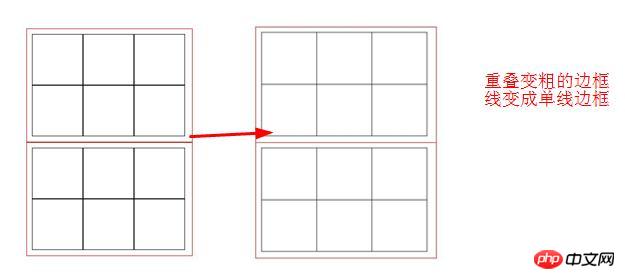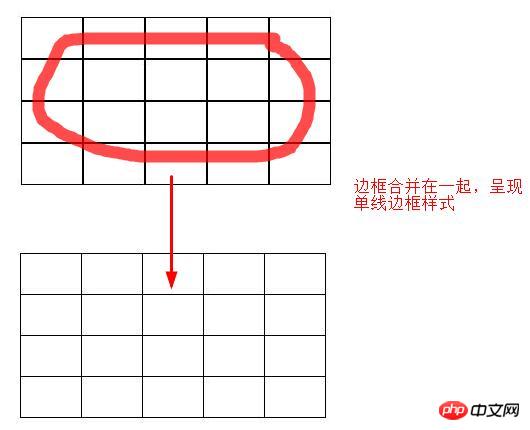How to remove overlapping borders with css?
In front-end development, the border attribute is a property that is often used. It can add borders to elements; but if two adjacent elements add borders at the same time, a problem will arise, and the borders will overlap. Together (as shown below), how to remove the borders of the overlapping parts?
This article will introduce to you how to solve border overlap in CSS, that is, how to remove overlapping borders in CSS, so that adjacent borders can be displayed as a single line. It has certain reference value. Friends in need can refer to it. I hope it will be helpful to you.

Border overlap can be divided into two situations, namely:
1. After setting borders on div, ul and other element boxes The overlapping problem
2. The overlapping problem after setting the border on the table
Now we will introduce how to solve these border overlapping problems, using simple code examples to explain
1. Overlapping problem after setting borders on div, ul and other element boxes
<!DOCTYPE html>
<html>
<head>
<meta charset="UTF-8">
<title>边框重叠</title>
<style>
ul li{list-style: none;}
.demo{
width: 310px;
height: 205px;
margin: auto;
padding: 10px;
border: 1px solid red;
margin-bottom:-1px ;
}
.demo li{
width: 100px;
height: 100px;
float: left;
border: 1px solid #000000;
margin:0px -1px -1px 0px ;
}
</style>
</head>
<body>
<div class="demo">
<ul>
<li></li>
<li></li>
<li></li>
<li></li>
<li></li>
<li></li>
</ul>
</div>
<div class="demo">
<ul>
<li></li>
<li></li>
<li></li>
<li></li>
<li></li>
<li></li>
</ul>
</div>
</body>
</html>Rendering:

In the above example, we use the negative value of the margin attribute and set the margin value of the element to the opposite number of the border value. This way the overlapping border can be hidden (covered) and the border can be displayed as a single line. . Negative margin is actually a very commonly used function, and many special layout methods rely on it.
2. Overlapping problem after setting borders in the table
table{
border-spacing: 0;
border-collapse: collapse;
}
table td {
border: 1px solid #000;
padding: 20px 30px;
}When we add borders to the form and remove the margins of each cell, The form will have the problem of overlapping borders, making the border line thicker. At this time, we can set border-collapse: collapse to set the border. It merges the overlapping borders together to form a border, achieving the effect of a single-line border.
Rendering:

Summary: The above is the method of removing overlapping borders in CSS introduced in this article. I hope it can be helpful to everyone’s learning. help. For more related tutorials, please visit: CSS tutorial, HTML tutorial, bootstrap video tutorial!
The above is the detailed content of How to remove overlapping borders with css?. For more information, please follow other related articles on the PHP Chinese website!

Hot AI Tools

Undresser.AI Undress
AI-powered app for creating realistic nude photos

AI Clothes Remover
Online AI tool for removing clothes from photos.

Undress AI Tool
Undress images for free

Clothoff.io
AI clothes remover

AI Hentai Generator
Generate AI Hentai for free.

Hot Article

Hot Tools

Notepad++7.3.1
Easy-to-use and free code editor

SublimeText3 Chinese version
Chinese version, very easy to use

Zend Studio 13.0.1
Powerful PHP integrated development environment

Dreamweaver CS6
Visual web development tools

SublimeText3 Mac version
God-level code editing software (SublimeText3)

Hot Topics
 What does placeholder mean in vue
May 07, 2024 am 09:57 AM
What does placeholder mean in vue
May 07, 2024 am 09:57 AM
In Vue.js, the placeholder attribute specifies the placeholder text of the input element, which is displayed when the user has not entered content, provides input tips or examples, and improves form accessibility. Its usage is to set the placeholder attribute on the input element and customize the appearance using CSS. Best practices include being relevant to the input, being short and clear, avoiding default text, and considering accessibility.
 What does span mean in js
May 06, 2024 am 11:42 AM
What does span mean in js
May 06, 2024 am 11:42 AM
The span tag can add styles, attributes, or behaviors to text. It is used to: add styles, such as color and font size. Set attributes such as id, class, etc. Associated behaviors such as clicks, hovers, etc. Mark text for further processing or citation.
 What does rem mean in js
May 06, 2024 am 11:30 AM
What does rem mean in js
May 06, 2024 am 11:30 AM
REM in CSS is a relative unit relative to the font size of the root element (html). It has the following characteristics: relative to the root element font size, not affected by the parent element. When the root element's font size changes, elements using REM will adjust accordingly. Can be used with any CSS property. Advantages of using REM include: Responsiveness: Keep text readable on different devices and screen sizes. Consistency: Make sure font sizes are consistent throughout your website. Scalability: Easily change the global font size by adjusting the root element font size.
 How to introduce images into vue
May 02, 2024 pm 10:48 PM
How to introduce images into vue
May 02, 2024 pm 10:48 PM
There are five ways to introduce images in Vue: through URL, require function, static file, v-bind directive and CSS background image. Dynamic images can be handled in Vue's computed properties or listeners, and bundled tools can be used to optimize image loading. Make sure the path is correct otherwise a loading error will appear.
 What is the function of span tag
Apr 30, 2024 pm 01:54 PM
What is the function of span tag
Apr 30, 2024 pm 01:54 PM
The SPAN tag is an inline HTML tag that is used to highlight text by applying attributes such as style, color, and font size. This includes emphasizing text, grouping text, adding hover effects, and dynamically updating content. It is used by placing <span> and </span> tags around the text you want to emphasize, and is manipulated via CSS styling or JavaScript. The benefits of SPAN tags include semantic clarity, styling flexibility, and ease of maintenance.
 How to wrap prompt in js
May 01, 2024 am 06:24 AM
How to wrap prompt in js
May 01, 2024 am 06:24 AM
When using the prompt() method in JavaScript, you can achieve line breaks through the following three methods: 1. Insert the "\n" character at the position where you want to break the line; 2. Use the line break character in the prompt text; 3. Use CSS's "white" -space: pre" style forces line breaks.
 What language is the browser plug-in written in?
May 08, 2024 pm 09:36 PM
What language is the browser plug-in written in?
May 08, 2024 pm 09:36 PM
Browser plug-ins are usually written in the following languages: Front-end languages: JavaScript, HTML, CSS Back-end languages: C++, Rust, WebAssembly Other languages: Python, Java
 What is node in js
May 07, 2024 pm 09:06 PM
What is node in js
May 07, 2024 pm 09:06 PM
Nodes are entities in the JavaScript DOM that represent HTML elements. They represent a specific element in the page and can be used to access and manipulate that element. Common node types include element nodes, text nodes, comment nodes, and document nodes. Through DOM methods such as getElementById(), you can access nodes and operate on them, including modifying properties, adding/removing child nodes, inserting/replacing nodes, and cloning nodes. Node traversal helps navigate within the DOM structure. Nodes are useful for dynamically creating page content, event handling, animation, and data binding.






